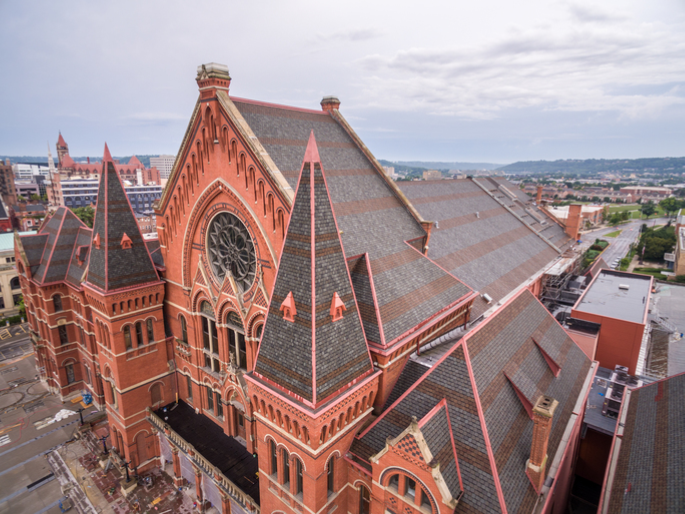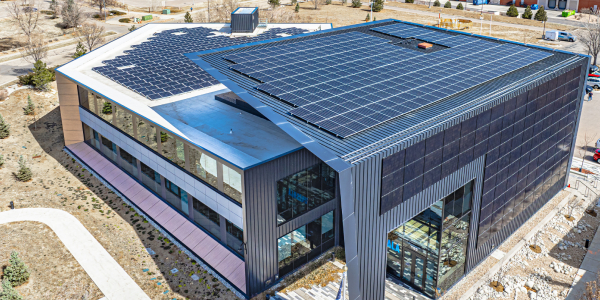Using Architectural Shingles to Revive Victorian-Gothic Architecture

Since the Music Hall is a National Historic Landmark, renovations must be true to the original design, and any departures from the original design must be approved by the U.S. Department of the Interior.
Founded in 1788, the city of Cincinnati is one of the Midwest’s oldest. It’s famed Over-the-Rhine neighborhood boasts among the world’s largest displays of Italianate architecture and design. The Cincinnati Music Hall –or Music Hall as it’s locally known– sits comfortably in downtown Cincinnati and is an extraordinary example of Victorian-Gothic architecture. First erected in 1878, the music hall gained fame for its beauty and for hosting the Cincinnati Opera, the second oldest in the nation.
However, in 2016 the 138-year-old structure was suffering from structural deterioration and a list of internal and external ailments, raising the alarm that one of the city’s most iconic structures was losing its gleam. Imbus Roofing, Inc. assessed the roof’s situation and deemed a replacement with modern asphalt shingles was necessary.
A Familiar Sight
The Music Hall and Imbus Roofing have a long history, with projects in 1988 and 2000. In 2016, it was time once again time for their help.
“We were at an advantage to win the project thanks to our previous work, we were even able to reference old photos to draw a clear picture of our capabilities,” said Andrew Imbus, lead project manager. “When we began, we were thankful to see there were no active leaks and little to no decking needed to be replaced.”
Work was done in conjunction with the interior renovations, noted Imbus.
“The building is massive, to say the least,” said Imbus. “We decided to break the project up between the south and main hall, allowing us to work in conjunction with the teams who were hired to perform the internal renovations below.”
Choosing a Roofing Material
Since the Music Hall is a National Historic Landmark, renovations must be true to the original design, and any departures from the original design must be approved by the U.S. Department of the Interior. The Music Hall is one of only 76 such landmarks in Ohio.
When the building was erected in 1878 by famed designer and Cincinnati native Samuel Hannaford, slate was used as the original roofing material, a decision common for the time. According to Imbus, the architectural team sought to maintain that original look and feel.
After options were carefully reviewed by all parties, including PWWG Architects, Midwest Roofing Supply and the Cincinnati Center City Development Corporation (3CDC), the architectural team selected asphalt shingles.
“Asphalt shingles were ultimately chosen for their appropriateness for the building, said Imbus. “Their durability factor and ability to imitate the natural appearance of slate systems were an added bonus. This helped maintain the original aesthetic of the Music Hall without following the original design step by step.”
Modernizing the Music Hall
Imbus chose to use approximately 600 squares of CertainTeed’s Grand Manor® shingles in Stonegate Gray and Brownstone, which matched the original color scheme and historical design elements provided by the National Historic Landmark.
The installation of 60,000 square-feet of shingles was a large task with a sensitive timeframe, according to Imbus. At times, the main crew would accomplish the varied tasks and at other times auxiliary crews were brought in to complete the work. For safety and access, all of the gutter edges were scaffolded, which was a challenge in some areas because of some tight footprints.
The roof also required seven new double leaf smoke hatches measuring 66 by 144 inches, which is among the largest smoke hatches on the commercial market. The hatches, which are designed to open in the event of a fire, needed to be framed and installed the same day the old roof was opened. This was because the internal renovations below were already complete, so the new installation had to be watertight before any kind of weather struck.
For underlayment, CertainTeed’s DiamondDeck® and WinterGuard® were selected to provide the complete asphalt roofing package. DiamondDeck® assists with weather protection through its scrim-reinforcement and water-resistant qualities. WinterGuard®, a composite material of asphalt and polymers, helps protect against water penetration. The asphalt makes the underlayment vapor-tight while the polymers provide elasticity and stickiness, allowing the barrier to stretch and seal around nails driven through it.
This steep-slope oriented project, which included large steeples boasting a 10:12 slope, also incorporated low-slope elements.
“For the small, low-slope sections we incorporated modified bitumen,” noted Imbus. “We felt low-slope asphalt roofing, like its steep-slope counterpart, offered an impressive lifecycle benefit. Not to mention its multi-layer / redundancy characteristic, which meant we’d be installing extremely long lasting systems, even though they were small in size.”
A Cincinnati Icon
The Music Hall renovation was an important milestone in the revitalization of Cincinnati’s downtown and Over-The-Rhine neighborhood. Following an investment from the community, the city of Cincinnati and the state of Ohio, the Music Hall reopened its doors on October 6, 2017 with a weekend full of festivities, re-establishing its rightful place as a cultural hub in the city.
The work of Imbus Roofing, Inc. was so impressive, the Music Hall was honored as the Gold winner in the Asphalt Roofing Manufacturers (ARMA)’s annual awards program, which seeks to recognize the best asphalt roofing projects every year in North America. If you have an asphalt roofing project, submit it to next year’s award at asphaltroofing.org.

-2025-xtv-mls-tour-2.png)




















Comments
Leave a Reply
Have an account? Login to leave a comment!
Sign In